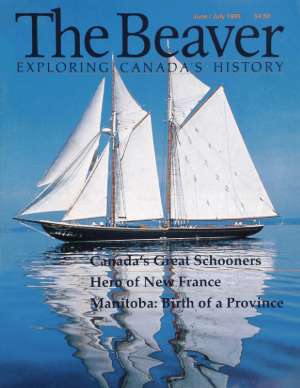Discover a wealth of interesting, entertaining and informative stories in each issue, delivered to you six times per year.
The Bluenose

Today it’s a national icon featured on the Canadian dime and a symbol of Nova Scotia’s legacy of shipbuilding excellence.
But on the brisk and blustery morning of March 26, 1921, the newly launched Bluenose entered the waters off Lunenberg, Nova Scotia, carrying the hopes and aspirations of an entire province. That was because the sleek schooner had been created with one purpose in mind — to defeat the swift New England schooners that at the time dominated the international sailing circuit.
Bluenose was designed by William J. Roué, a local marine architect, built by Smith & Rhuland Shipyard of Lunenberg, and captained by local sailor Angus Walters. A working schooner, Bluenose and its crew headed to the Grand Banks off Newfoundland to fish in the summer of 1921, all the while focusing on the schooner’s first major test — the International Fishermen’s Race slated for October of that year.
Bluenose not only found glory at that race but went on to dominate international sailing racing for the next decade.
In the 1930s, the vessel found further fame, representing Canada at the 1933 world’s fair in Chicago and taking part in the 1935 silver jubilee of King George V. Here, it’s seen winning the final leg of the 1938 International Fishermen’s Trophy series to capture the championship over the American schooner Gertrude L. Thebaud, which sailed out of Massachusetts.
Sadly, there was one opponent Bluenose could not defeat — time. With the age of sail at an end, Bluenose was fitted with diesel engines and sold in 1942 to ply the waters as a tramp schooner in the Caribbean. It was reported that Captain Walters stood on the dock at Lunenberg and wept as his newly sold ship departed Nova Scotia for the final time.
In 1946, during a January squall, it ran aground on a coral reef and then sank off the coast of Haiti.
In 1963, a replica of the schooner was built. Gifted to the province of Nova Scotia in 1971, Bluenose II continues to act as an ambassador both for the province and for Canada.
Themes associated with this article
Advertisement
You might also like...

Canada’s History Archive, featuring The Beaver, is now available for your browsing and searching pleasure!











